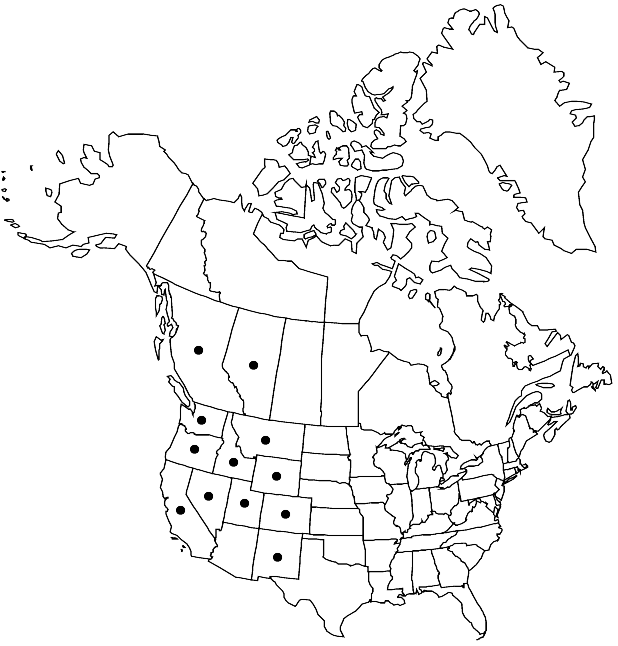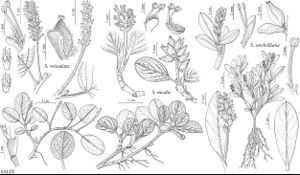Salix nivalis
Fl. Bor.-Amer. 2: 152. 1838.
Plants 0.01–0.04 m, (dwarf, forming clonal mats by rhizomes). Stems trailing or erect; branches yellow-brown or red-brown, glabrous or pubescent; branchlets yellow-brown or red-brown, glabrous or pilose. Leaves: stipules absent or rudimentary; petiole 1.5–7 mm (sometimes glandular distally or throughout); largest medial blade hypostomatous, (veins impressed-reticulate, 2 pairs of secondary veins arising at or close to base, arcing toward apex,), elliptic to broadly elliptic, 6–22 × 4–15 mm, 1.1–2.8 times as long as wide, base convex, rounded, subcordate, or cuneate, margins slightly revolute, entire (glandular-dotted), apex convex, rounded, or retuse, abaxial surface glabrous or with long-silky hairs, adaxial slightly glossy, glabrous; proximal blade margins entire; juvenile blade glabrous. Catkins: staminate 7–19 × 2.5–6 mm, flowering branchlet 0.5–17 mm; pistillate densely to loosely flowered (4–17 flowers), stout, subglobose or globose, 7–21 × 2–9 mm, flowering branchlet 1–10 mm; floral bract tawny or light rose, 0.8–1.8 mm, apex rounded, entire, abaxially glabrous. Staminate flowers: abaxial nectary 0.5–1.3 mm, adaxial nectary narrowly oblong, oblong, or square, 0.5–1.2 mm, nectaries connate and cup-shaped; filaments distinct, glabrous or hairy basally; anthers ellipsoid or shortly cylindrical, 0.4–0.6 mm. Pistillate flowers: abaxial nectary (0–)0.2–0.5 mm, adaxial nectary oblong, 0.2–1 mm, longer than stipe, nectaries distinct or connate and shallowly cup-shaped; stipe 0–0.8 mm; ovary obturbinate, short-silky, hairs flattened, beak abruptly tapering to styles; ovules 8–10 per ovary; styles distinct to connate 1/2 their lengths, 0.2–0.4 mm; stigmas flat, abaxially non-papillate with rounded tip, 0.2–0.26–0.36 mm. Capsules 3–4 mm. 2n = 38.
Phenology: Flowering late Jun-late Aug.
Habitat: Alpine tundra, cirques, lake basins, rocky slopes and ridges, fellfields
Elevation: 1900-4000 m
Distribution

Alta., B.C., Calif., Colo., Idaho, Mont., Nev., N.Mex., Oreg., Utah, Wash., Wyo.
Discussion
Because geographic overlap is small and evidence of intergradation is tenuous, Salix nivalis is best treated as a species separate from S. reticulata; S. nivalis was previously treated as a subspecies of S. reticulata (G. W. Argus 1986b, 1991).
Selected References
None.
